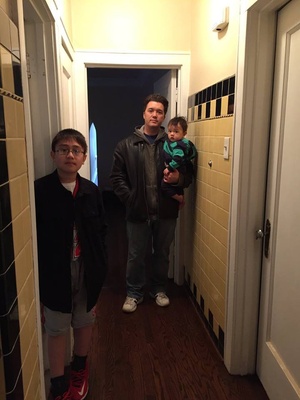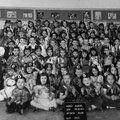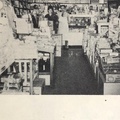Gaining early educational release from incarceration at Gila River War Relocation Center in 1943, my Nisei grandparents moved to St. Paul, MN, where my grandfather enrolled in welding school. With a certified trade and some experience under his belt, in 1945 they moved—along with my infant father—to Chicago for its wealth of industrial opportunities. Initially renting a room in the recently-formed Japanese district at Clark and Division from another Matsunaga family they’d priorly known from the West Coast, they found more permanent lodgings in a tenement-style apartment on Halsted Street near Webster Avenue in the Lincoln Park neighborhood. At this location the units on each floor shared a communal hallway bathroom. A few years later, as their family grew to three children in addition to their hosting the occasional relocated family member in transition, they were ready to upsize.
For the next five years they rented an apartment at 13th and Independence in the Lawndale neighborhood on Chicago’s West Side, far from the Japanese community they’d transitioned into but happy their unit had its own bathroom. Upon learning that a friend in the North Side neighborhood of Lakeview was vacating their place upon return to the West Coast, in 1954 Gramps moved the family to Diversey and Sheffield, into the three-bedroom first floor apartment of a two-flat formerly occupied by the Ekinaka family. By the early 1960s they had saved enough to put down on a home of their own and in 1964 purchased a brick two-flat near Loyola University in the Far North Side neighborhood of Rogers Park, where they occupied the first floor apartment and rented the second floor.
Born ten years after its purchase, it was the only home I knew them to have and always considered this building to represent Matsunaga General Headquarters, a common ground where any of our family could meet at any time and be on equal terms. Five generations of us have planted our feet here, from my Issei great-grandparents to my Gosei children. Many of us lived in this building at some point. Chicago being the transportation hub it is, many of our out-of-town relatives passed through these walls on their way elsewhere. The family gathered here for all major holidays and on your average whenever day, too. Like most families ours had its occasional differences and at any given time a brother, an aunt, an uncle, a cousin might not be jibing with another. Although we may not have visited each other at our own homes during these periods, this house always represented to me a demilitarized zone where I could enjoy the company of all my relatives at once no matter who was or wasn’t getting along with whom—though for the most part we all remained pretty close knit over the years, sometimes people need space, what are you gonna do.
After high school I was privileged to have the opportunity to study at Loyola University, which in great part I chose because of my familiarity with it through many childhood weekend afternoons spent skateboarding and walking the dog on its campus. I stopped in on Grandma and Gramps every day for years both during and after college and came to feel more at home there than at my own parents’, as my folks had moved from my childhood home when I was in high school. My grandparents’ became the one place in my lifetime that had never changed. I enjoyed the opportunity to get to know my father’s folks, as my mother’s were of an older generation and had both passed by the time I was in second grade. Through often directionless storytelling, they taught me much of our family’s history and opened my eyes to avenues of further research into that of our extended family and greater community.

My Nisei grandparents passed gently in 2011, my grandmother in January and Gramps in December, having reached their ripe 90s. They left a legacy of children, grandchildren, great-grandchildren, and this building. But property management and cooperative maintenance is a multifaceted expense and we all have our own families and homes to take care of. It was time to let go, and the family closed on its sale in 2015 after fifty-one memorable years. Before closing, we paid one last visit. Schedules being what they are my wife and I could not make it with our kids the same time as the rest of the family, but it worked out for the best. After playing a game of “Remember When,” my wife took our kids to the car and let me say my goodbyes in peace. It was an emotional free-fall to walk out that door for the final time, accompanied by a deeply heartfelt appreciation to have had such an opportunity to experience this sense of family and place.
© 2015 Erik Matsunaga






